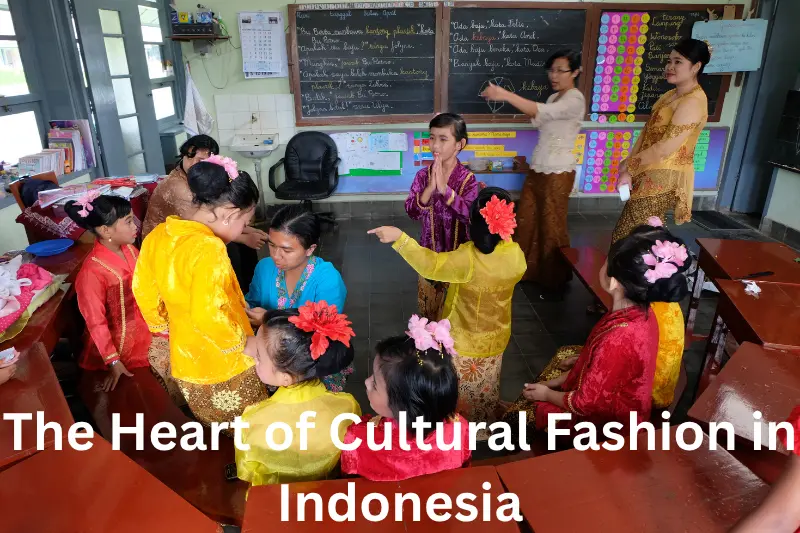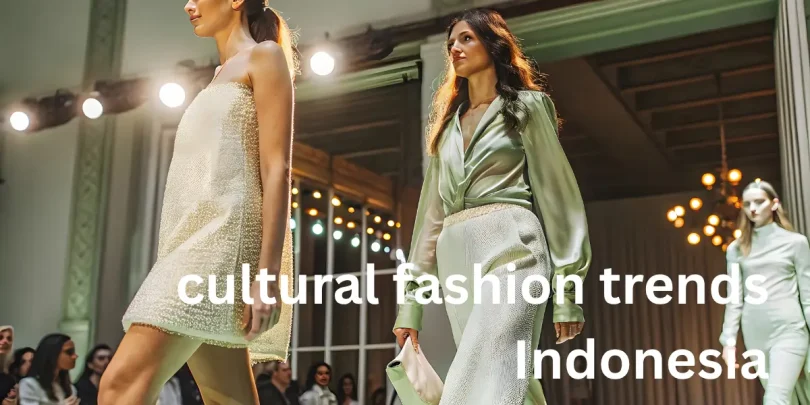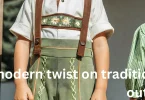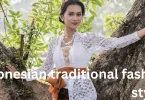Ever stood in front of your closet wondering why your outfits feel so plain or disconnected from who you really are? You’re not alone. So many of us crave something deeper in fashion—something that feels meaningful, expressive, and rooted in identity. That’s exactly where cultural fashion trends Indonesia step in. This isn’t just about pretty fabrics or eye-catching prints; it’s about wearing stories, heritage, and pride. Indonesian fashion is an incredible fusion of art, culture, and modern creativity, and what makes it even more special is how it continues to evolve while staying true to its roots. Real talk? It’s fashion with a heartbeat. It’s the kind of style that makes you feel connected—to your culture, your people, and even yourself. If you’ve ever wondered how to mix tradition with modern style or how Indonesian designers are redefining global fashion, let’s dive deep into this beautiful journey together and uncover why the world can’t stop talking about cultural fashion in Indonesia.
The Heart of Cultural Fashion in Indonesia

Indonesia’s fashion scene is more than just trends; it’s a reflection of centuries of artistry, beliefs, and social identity. Every pattern, thread, and motif carries stories from the past, and each region has something different to tell. From the regal woven songket of Sumatra to the intricate batik from Java, fashion in Indonesia has always been a mirror of diversity. The fascinating thing is how fashion has long been a cultural language—before words, people expressed themselves through what they wore. A batik motif could represent one’s social class, family lineage, or even moral values. This shows how fashion and culture in Indonesia are inseparable. But here’s what makes it even more beautiful: this connection hasn’t faded with time. Instead, it’s evolved. What we’re seeing today is a new wave of Indonesian designers and fashion lovers who are proudly carrying forward these traditions while giving them a contemporary edge.
The Rise of Cultural Fashion Trends Indonesia
The growing fascination with cultural fashion trends Indonesia didn’t happen overnight. It’s been building quietly but powerfully as younger generations begin to rediscover and redefine their cultural identities. Modern Indonesians are realizing that traditional fashion doesn’t have to be old-fashioned—it can be bold, stylish, and modern. They’re saying goodbye to the outdated belief that traditional wear is only for weddings or ceremonies. Today, you’ll find young people wearing batik jackets to the office, pairing tenun skirts with sneakers, and rocking kebaya-inspired tops at parties. The new mindset is simple: tradition isn’t something to be hidden; it’s something to flaunt proudly. And thanks to social media, this movement is growing faster than ever. Platforms like Instagram and TikTok have allowed local artisans and small designers to reach a global audience, turning what used to be niche local crafts into mainstream fashion inspiration. When you see influencers mixing traditional fabrics with contemporary cuts, it doesn’t just look good—it feels powerful, like a cultural statement that says, “This is who we are.”
The Cultural Threads That Weave Indonesian Fashion
To really understand cultural fashion trends Indonesia, we need to appreciate the diversity behind them. Indonesia has over 17,000 islands, and each one contributes to the nation’s rich tapestry of fashion traditions. There’s batik from Java, tenun from Bali and Nusa Tenggara, songket from Sumatra, ulos from North Sumatra, and so many more. Every piece has its own symbolism, technique, and color story that reflects local beliefs and lifestyles.
Batik – The Soul of Indonesian Style
Batik isn’t just fabric; it’s emotion, patience, and history woven together. The process of creating batik—applying wax and dye by hand—is incredibly intricate. Each pattern is symbolic. Some represent luck, prosperity, or balance, while others were once worn only by royalty. What’s even more exciting is how batik has transformed. Modern batik designs now appear in everyday wear—on sneakers, tote bags, office shirts, and even evening gowns. This reinvention shows that while trends change, batik remains eternal, adapting beautifully to every era.
Kebaya – The Symbol of Grace and Femininity
Few garments capture elegance the way a kebaya does. Traditionally worn with a sarong, the kebaya has always represented Indonesian femininity and poise. Over time, modern designers have given it new life by experimenting with different materials, colors, and cuts. Today, you can find kebaya styles that are minimalist, edgy, or even infused with streetwear aesthetics. What remains constant is its aura of grace—it makes anyone wearing it feel empowered, beautiful, and proud.
Tenun and Songket – The Pride of Indonesian Weaving
Tenun and songket are handwoven masterpieces that take weeks or even months to complete. They’re often passed down through generations, symbolizing heritage and perseverance. Songket, in particular, shines with metallic threads that create luxurious patterns perfect for special occasions. Modern designers are blending these traditional fabrics with everyday fashion—turning what was once ceremonial wear into casual yet elegant statements.
Designers Bridging the Past and the Present

Here’s the deal: Indonesian designers are masters at storytelling. Through their designs, they weave history into modern silhouettes, ensuring that each collection feels rooted yet relevant. Designers like Anne Avantie, Didiet Maulana, and Oscar Lawalata have proven that tradition can coexist with innovation. Their work highlights the beauty of cultural elements without making them feel old-fashioned. Instead of copying Western trends, they focus on reinterpreting Indonesian heritage for the global stage. You’ll see structured jackets made from tenun, flowy dresses inspired by batik patterns, and kebayas reimagined for the red carpet. What makes this even more impactful is that many of these designers also support local artisans, ensuring that traditional craftsmanship remains alive and valued.
Sustainability and Culture: A Perfect Match
One of the most inspiring aspects of cultural fashion trends Indonesia is how it naturally aligns with sustainability. Many traditional Indonesian fabrics are handcrafted using eco-friendly materials and techniques that have existed for centuries. These slow-fashion practices are the opposite of mass production—they focus on quality, longevity, and respect for the environment. When you buy a handmade batik or tenun piece, you’re not just purchasing clothing; you’re supporting entire communities of artisans who rely on these crafts for their livelihoods. More brands are now embracing ethical sourcing and transparent production methods, blending cultural preservation with modern responsibility. This makes Indonesian cultural fashion not only beautiful but also meaningful—a movement toward mindful living and sustainable elegance.
Bringing Cultural Fashion Into Your Everyday Life
Let’s be honest—many people admire cultural fashion but don’t know how to wear it daily without feeling too “dressed up.” The trick is to start small and stay confident. Begin with simple elements like a batik-patterned shirt, a tenun belt, or an ethnic-print bag. These subtle touches can instantly elevate your look without feeling overwhelming. Once you feel comfortable, you can go bolder—maybe a kebaya blouse paired with modern trousers or a songket-inspired skirt with a tucked-in white tee. Mixing traditional and modern pieces creates a balanced, effortless look that celebrates your roots while keeping things stylish. Another pro tip? Pay attention to accessories. Handcrafted jewelry, woven handbags, or statement scarves can add the perfect finishing touch. The key is to wear it with pride—because when you feel connected to what you’re wearing, it always looks better.
The Global Influence of Indonesian Fashion
The beauty of cultural fashion trends Indonesia has reached beyond the country’s borders. International designers and influencers are increasingly inspired by Indonesian patterns and textiles. Batik has appeared on global runways, in luxury collections, and even in collaborations between local artisans and major fashion houses. Celebrities have been spotted wearing Indonesian-inspired designs at high-profile events, helping to showcase this rich cultural artistry on the world stage. This exposure is not only boosting pride among Indonesians but also opening new economic opportunities for local weavers and designers. The world is finally recognizing what Indonesia has always known: its culture is a wellspring of creativity, elegance, and storytelling.
Challenges in Preserving Cultural Fashion
While this cultural renaissance is exciting, it’s not without its challenges. One major issue is cultural commercialization—when traditional designs are mass-produced by companies that don’t understand their meaning or origins. This can strip away authenticity and reduce cultural symbols to mere aesthetics. Another challenge is supporting local artisans. Many of them face difficulties competing with fast fashion, despite their superior craftsmanship. Consumers can make a big difference here by choosing to buy directly from local creators, learning the stories behind the designs, and promoting ethical fashion. Preservation doesn’t mean keeping things locked in the past; it means ensuring that tradition continues to evolve respectfully and meaningfully.
Why Cultural Fashion Matters More Than Ever
In a world obsessed with speed and newness, cultural fashion offers something grounding. It reminds us of who we are, where we come from, and what values we carry. It’s not just about wearing clothes—it’s about expressing identity and belonging. The beauty of cultural fashion trends Indonesia is that it celebrates unity in diversity. Every fabric, color, and motif tells a story of a different region, yet together they form one cohesive cultural identity. Wearing Indonesian-inspired fashion is a way of saying, “I’m proud of my heritage, and I want to share it with the world.” It connects generations, supports communities, and inspires creativity.
Simple Checklist: Start Your Cultural Fashion Journey
To help you take your first steps into this world of meaningful style, here’s a quick checklist you can follow.
- Learn the history and story behind traditional fabrics before buying them.
- Support local artisans and small brands that value authenticity.
- Start with one traditional piece and mix it with your everyday outfits.
- Choose quality over quantity—handcrafted pieces are timeless.
- Wear your cultural fashion with pride and share its story with others.
Conclusion
At its heart, fashion is self-expression—but when that expression is tied to heritage, it becomes something far deeper. Embracing cultural fashion trends Indonesia isn’t just about looking stylish; it’s about honoring the craftsmanship, passion, and history that define a nation’s soul. Whether you choose to wear a modern kebaya, a vibrant tenun skirt, or a sleek batik jacket, you’re carrying centuries of artistry on your shoulders. You’re keeping traditions alive while shaping the future of fashion. So go ahead—dress with intention, walk with pride, and let every thread you wear tell a story that’s authentically you.
FAQs
What are cultural fashion trends Indonesia?
Cultural fashion trends Indonesia reflect how traditional fabrics, patterns, and attire like batik, kebaya, and songket blend with modern styles to create unique, elegant fashion looks.
How do Indonesian designers incorporate tradition into modern fashion?
Indonesian designers use traditional motifs, fabrics, and handcrafting methods in contemporary designs, creating outfits that honor heritage while staying trendy.
Why is batik important in Indonesian fashion?
Batik is a symbol of identity and culture in Indonesia. Its intricate patterns and dyeing techniques represent stories, values, and traditions passed through generations.
What makes Indonesian cultural fashion unique?
Its uniqueness lies in the rich cultural diversity — every region has distinct textiles, colors, and craftsmanship that make Indonesia’s fashion deeply expressive and meaningful.
How is cultural fashion influencing youth in Indonesia?
Young Indonesians are proudly embracing traditional elements by mixing them with streetwear and modern designs, making cultural fashion a vibrant trend again.



